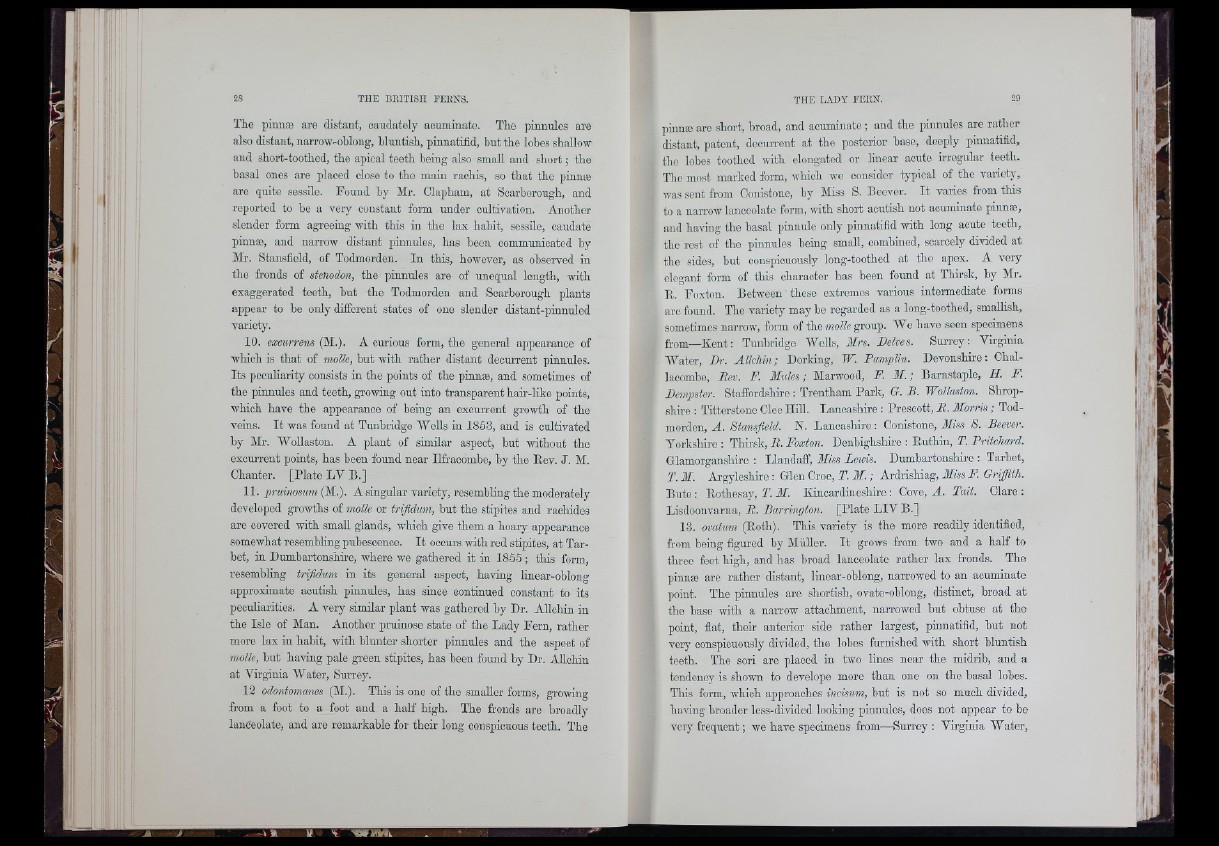
The pinnæ are distant, caudately acuminate. The pinnules are
also distant, narrow-oblong, bluntish, pinnatifid, but the lobes shallow
and short-toothed, the apical teeth being also small and short ; the
basal ones are placed close to the main raohis, so that the pinnæ
are quite sessile. Found by Mr. Clapham, at Scarborough, and
reported to be a very constant form under cultivation. Another
slender form agreeing with this in the lax habit, sessile, caudate
pinnæ, and narrow distant pinnules, has been communicated by
Mr. Stansfiold, of Todmorden. In this, however, as observed in
the fronds of stetiodon, the pinnules are of unequal length, with
exaggerated teeth, but the Todmorden and Scarborough plants
appear to be only different states of one slender distant-pinnuled
variety.
10. exeurrens (M.). A curious form, tbe general appearance of
wbiob is that of molle, but witb rather distant decurrent pinnules.
Its peculiarity consists in the points of the pinnæ, and sometimes of
the pinnules and teeth, growing out into transparent hair-lite points,
which have the appearance of being an exourrent growth of the
veins. It was found at Tunbridge WeUs in 1853, and is cultivated
by Mr. Wollaston. A plant of similar aspect, but without the
exourrent points, has been found near Ilfraoombo, by the Rev. J. M.
Chanter. [Plate LV B.]
11. pnunosum (M.). A singular variety, resembling the moderately
developed growths of molle or trifldimi, but tlie stipites and racbides
are covered with small glands, which give them a hoary appearance
somewhat resembling pubescence. It occurs with red stipites, at Tarbet,
in Dumbartonshire, where we gathered it in 1855 ; this form,
resembling trifldum in its general aspect, having linear-oblong
approximate acutish pinnules, has since continued constant to its
peculiarities. A very similar plant was gathered by Dr. Allchin in
the Isle of Man. Another pruinose state of the Lady Fern, rather
more lax in habit, witb blunter shorter pinnules and the aspect of
molle, but having pale green stipites, has been found by Dr. Allchin
at Virginia Water, Surrey.
12 odontomanes (M.). This is one of the smaller forms, growing
from a foot to a foot and a half high. The fronds are broadly
lanceolate, and are remarkable for tbeir long conspicuous teeth. The
pinnæ are short, broad, and aomninato ; and the pinnules arc rather
distant, patent, decurrent at the posterior base, deeply pinnatifid,
the lobos toothed with elongated or linear acute irregular teeth.
The most marked form, which wo consider typical of the variety,
was sent from Conistone, by Miss S. Beovor. It varies from this
to a narrow lanceolate form, with short acutish not acuminate pinnæ,
and having the basal pinnule only pinnatifid with long acute tooth,
the rest of the pinnules being small, combined, scarcely divided at
the sides, but conspicuously long-tootbed at the apex. A very
elegant form of this character has boon found at Thirsk, by Mr.
R. Foxton. Between these extremes various intermediate forms
are found. The variety may bo regarded as a long-toothed, smallish,
sometimes narrow, form of the«?.o/fe group. We have seen specimens
from—Kent : Tunbridge Wells, Mrs. Delves. Surrey : Virginia
Water, Dr. Allchin; Dorking, IK. Pamplin. DevonsHre: Chal-
lacombe, Dev. F. Mules ; Marwood, F. M. ; Barnstaple, H. F.
Dempster. Staffordshire : Trentham Park, O. B. Wollaston. Shropshire
: Titterstone Clee Hill. Lancashire : Prescott, B. Morris ; Tod-
mordon, A. Stansfleld. N. Lancashire : Conistone, Miss S. Beever.
Yorkshire : Thirsk, B. Foxton. Denbighshire : Ruthin, T. Pritchard.
Glamorganshire : Llandaff, Miss Lewis. Dumbartonshire : Tarbet,
T. M. Argyleshire : Glen Croe, T. M. ; Ardrishiag, Miss F. Griffith.
Bute : Rothesay, T. M. Kincardineshire : Cove, A. Tait. Clare :
Lisdoonvarna, B. Barrington. [Plate LIV B.]
13. ovatum (Both). This variety is the more readily identified,
from being figured by Müller. It grows from two and a half to
three feet high, and has broad lanceolate rather lax fronds. The
pinnæ are rather distant, linear-ohlong, narrowed to an acuminate
point. The pinnules are shortish, ovate-oblong, distinct, broad at
the base witb a narrow attachment, narrowed but obtuse at tbe
point, flat, their anterior side rather largest, pinnatifid, but not
very conspicuously divided, the lobes furnished witb short bluntish
teeth. The sori are placed in two lines near the midrib, and a
teudoncy is shown to develope more than one on the basal lobes.
This form, which approaches incisum, but is not so much divided,
having broader less-divided looking pinnules, does not appear to be
very frequent ; we have specimens from—Surrey : Virginia Water,
■'.ill
i! ■ i
I '.E
I I
I ■: -
M’..
I
'ii
'if